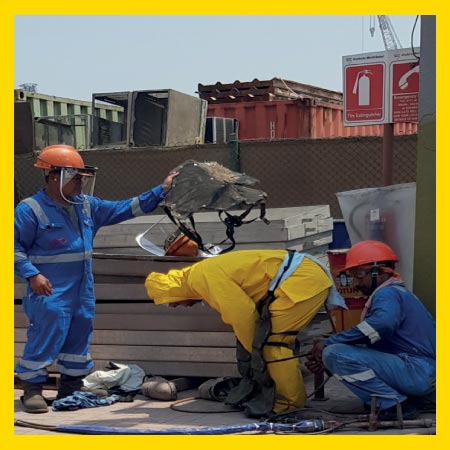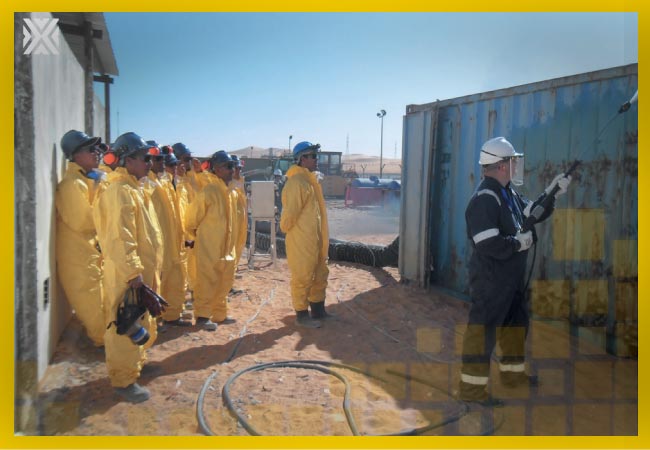Currency
April 04, 2022

High pressure water jetting is vital for the petrochemical industry. High quality training, safe systems and new technology ensure it can be carried out safely, says the Water Jetting Association.
Water jetting is vital to the petrochemical industry. It is used for cleaning and de-fouling a huge range of equipment, including heat exchangers, process vessels, holding tanks, large-diameter pipes and site drainage systems.
It is also used for surface preparation during construction and structural maintenance and intrinsically safe cold-cutting and hydrodemolition.
Water jetting delivers excellent results and is better for the environment than alternative mechanical approaches. Without water jetting, it is fair to say, the petrochemical industry would grind to a halt.
However, water jetting is a risky business. Which is why, 40 years ago this year, the Water Jetting Association (WJA) was established in the UK.
It was the first association of its kind in the world. Now its members, which include water jetting contractors, training providers and equipment manufacturers, are at the forefront of efforts to raise water jetting quality standard and skills in the Middle East and Africa.
Water jets at pressures as a low as 7 bar, or 100 pounds per square inch (PSI), can penetrate skin, causing damage to internal tissue.
High pressure water jetting (HPWJ) is carried out at pressures up to 1,700 bar (25,000psi). Ultra-high pressure water jetting (UHPWJ) reaches 2,700 bar (40,000psi) and beyond.

At these pressures, fluid injection injuries can be very serious indeed.
Research commissioned by the WJA, published in 2019, [See WJA Medical Guidelines below] highlighted two critical consequences of high pressure fluid injection injuries (HPFII).
Firstly, the trauma can be so severe that people die rapidly from loss of blood. Secondly, less traumatic injury still has the potential to cause life-changing injury or death.
As a result, the WJA has written into its two codes of practice (for HPWJ and UHPWJ and for safe use of water jetting in sewers) measures that must be taken to control these risks. These include:
Therefore, water jetting can often be safer and more productive than using electro-mechanical and pneumatic tools, such as jackhammers and power chisels, which are well known for their HAV injury risks.
The HSE’s research concluded that there was no need to take measures to reduce exposure to vibration when carrying out HPWJ with single jet equipment. Control measures would have to be considered when using orbital or rotating jetting nozzles.
“One of the biggest hazards is the failure of other people on a worksite to understand the kinetic power of water jets,” he explained.
“This can result in workers entering a controlled area, disturbing a water jetting operative, or interfering with equipment which will put them and others at risk.”
Steve Williams is a UK-based WJAapproved training instructor. Like his instructor colleagues, he has opportunities to train operatives around the world.
He is struck by the growing awareness of the importance of both quality standards and training among contractors and the willingness to learn demonstrated by operatives on his courses.
“We’ve witnessed notable and positive behaviour changes as access to training and knowledge-sharing spreads across the Middle East,” said Williams.
“Contractors are using the right PPE and practicing standard, safe practices for high-pressure jetting applications. They are investing in the latest semiautomated cleaning methods and learning how to better maintain and optimise their high-pressure equipment.”
Another WJA-approved instructor, Roy Dykes, agrees real progress is being made in terms of recognition that training and safety standards are important, with more still to be achieved.
He believes standards are being lifted across the region by big and visible projects such as construction for the FIFA World Cup in Qatar in 2022. But, he says, the oil and gas industry still has the biggest influence.
Large companies like Qatar Gas are setting standards which others are being encouraged to follow,” he said. “Qatar Gas is very active across the region and is taking its approach to water jetting safety with it, which is helping to establish the WJA’s codes of practice as the water jetting ‘gold standard’ in the Middle East.
“The codes of practice have been continuously updated by people who’re at the sharp end of water jetting,” he added. “They’re recognised by all the major petrochemical companies, which is positive because it’s creating a consistent, high quality approach to safety across the region.”
Water jetting is vital to the petrochemical industry. It is used for cleaning and de-fouling a huge range of equipment, including heat exchangers, process vessels, holding tanks, large-diameter pipes and site drainage systems.
It is also used for surface preparation during construction and structural maintenance and intrinsically safe cold-cutting and hydrodemolition.
Water jetting delivers excellent results and is better for the environment than alternative mechanical approaches. Without water jetting, it is fair to say, the petrochemical industry would grind to a halt.
However, water jetting is a risky business. Which is why, 40 years ago this year, the Water Jetting Association (WJA) was established in the UK.
“water jets at pressures as low as 7 bar, or 100 pounds per square inch (PSI), can penetrate skin, causing damage to internal tissue”
It was the first association of its kind in the world. Now its members, which include water jetting contractors, training providers and equipment manufacturers, are at the forefront of efforts to raise water jetting quality standard and skills in the Middle East and Africa.
Hand and arm risks and protection
Hand and arm injury is a major concern in any industrial process. With water jetting, a key issue is the risk of fluid injection injury or major trauma caused by water jets striking the body.Water jets at pressures as a low as 7 bar, or 100 pounds per square inch (PSI), can penetrate skin, causing damage to internal tissue.
High pressure water jetting (HPWJ) is carried out at pressures up to 1,700 bar (25,000psi). Ultra-high pressure water jetting (UHPWJ) reaches 2,700 bar (40,000psi) and beyond.

At these pressures, fluid injection injuries can be very serious indeed.
Research commissioned by the WJA, published in 2019, [See WJA Medical Guidelines below] highlighted two critical consequences of high pressure fluid injection injuries (HPFII).
Firstly, the trauma can be so severe that people die rapidly from loss of blood. Secondly, less traumatic injury still has the potential to cause life-changing injury or death.
As a result, the WJA has written into its two codes of practice (for HPWJ and UHPWJ and for safe use of water jetting in sewers) measures that must be taken to control these risks. These include:
- Safe systems of work (SSoW) to control the risk of hand and arm injury. These include using jetting guns and lances of a specified design and length which prevent a water jet from be directed at the operative’s body.
- Where hand-held jetting guns or lances are being used, operatives must wear specialist PPE, including full body suits and additional arm gauntlets, if needed. These suits are made from ultra-tough materials, designed to withstand the forces exerted by water jets.
- Moving the operative away from the water jets by using semi-automatic and automatic water jetting equipment, also known as robotic equipment.
Avoiding HAVs
Research carried out by the UK Health and Safety Executive’s (HSE) Health and Safety Laboratory on behalf of the WJA confirmed HPWJ using single-jet equipment does not create a risk of hand-arm vibration (HAV).Therefore, water jetting can often be safer and more productive than using electro-mechanical and pneumatic tools, such as jackhammers and power chisels, which are well known for their HAV injury risks.
The HSE’s research concluded that there was no need to take measures to reduce exposure to vibration when carrying out HPWJ with single jet equipment. Control measures would have to be considered when using orbital or rotating jetting nozzles.
Training and site control
John Jones, WJA Vice-President and Chairman of its Training and Safety Committee, said safety awareness training for all site workers, backed by effective site controls, is still vital“One of the biggest hazards is the failure of other people on a worksite to understand the kinetic power of water jets,” he explained.
“This can result in workers entering a controlled area, disturbing a water jetting operative, or interfering with equipment which will put them and others at risk.”
Water jetting surge
Effective training is at the heart of risk control. Water jetting training has developed significantly in the Middle East over the last 10 years, which is having a significant impact on health and safety standards.Steve Williams is a UK-based WJAapproved training instructor. Like his instructor colleagues, he has opportunities to train operatives around the world.
He is struck by the growing awareness of the importance of both quality standards and training among contractors and the willingness to learn demonstrated by operatives on his courses.
“We’ve witnessed notable and positive behaviour changes as access to training and knowledge-sharing spreads across the Middle East,” said Williams.
“Contractors are using the right PPE and practicing standard, safe practices for high-pressure jetting applications. They are investing in the latest semiautomated cleaning methods and learning how to better maintain and optimise their high-pressure equipment.”
Another WJA-approved instructor, Roy Dykes, agrees real progress is being made in terms of recognition that training and safety standards are important, with more still to be achieved.
He believes standards are being lifted across the region by big and visible projects such as construction for the FIFA World Cup in Qatar in 2022. But, he says, the oil and gas industry still has the biggest influence.
“large companies like Qatar Gas are setting standards which others are being encouraged to follow”
Large companies like Qatar Gas are setting standards which others are being encouraged to follow,” he said. “Qatar Gas is very active across the region and is taking its approach to water jetting safety with it, which is helping to establish the WJA’s codes of practice as the water jetting ‘gold standard’ in the Middle East.
“The codes of practice have been continuously updated by people who’re at the sharp end of water jetting,” he added. “They’re recognised by all the major petrochemical companies, which is positive because it’s creating a consistent, high quality approach to safety across the region.”









